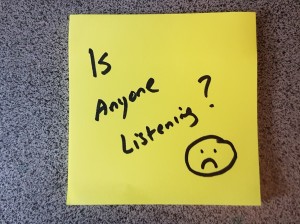 Information radiators are a great idea.
Information radiators are a great idea.
After all, who wouldn’t want to reduce the effort involved in keeping stakeholders up-to-date about a product or project or increase the consistency in messaging to all stakeholders?
But convincing executives to use information radiators as a primary means of staying current is not an easy task. Yes, there might be a few early adopters who are open to trying a different way but most are likely to prefer to receive these updates the way they’ve always got them through one-on-one or steering committee meetings using status reports. So project managers or Product Owners spend time harvesting and curating information from the radiators into traditional status reports or presentation decks.
This introduces a few challenges:
- The activity of creating these reports or presentation decks is non-value add
- The information shared is likely to be somewhat stale
- There is an increased likelihood of reduced transparency as the “warts & all” information available in radiators might have been redacted or modified to fit the spin which the publisher wished to portray
So how can we help executives through the transition to using information radiators?
Start with why – if they don’t understand how traditional reporting approaches hurt them, they are unlikely to have any sense of urgency about adopting a different approach. Whether it is reducing delivery costs or improving the quality of information presented, find out what concerns them and use that as a lever for change.
Second, you will want to ensure that the information radiators being published are relevant to senior stakeholders. Taking the time to understand what they need to support their decision making should help in creating dashboards which they will actually want to use.
Finally, rather than asking them to make the significant leap from a meeting-based approach to a self-service model, consider continuing the meetings, but use information radiators as the supporting materials for the discussions in place of traditional presentation decks. This should spark your stakeholders’ curiosity as they are likely to ask questions based on their interpretation of the information published which will provide you with an opportunity to provide live “color commentary” about the project or product’s status.
If you want management to change, you need to apply effective change management.





Pingback: New PM Articles for the Week of May 13 – 19 | The Practicing IT Project Manager